Details:
We present today a journey to discover the traditional flavors of a particular territory, the area of Polesine. The magazine Sapori d’Italia offers us great suggestions for enjoying the best cuisine in the area, along with the deals of Agriturismi.it for a special stay.
From the waters of the Po Delta are 70% of the mussels and clams produced in Italy which with the eel, blue fish, rice and vegetables, give life to a kitchen in perfect harmony with an environment that is always a discovery for the attentive and curious naturalist, who recognizes diversity. The Po river is the undisputed leader of this land, a creative force that at the same time threatens the land, and over the centuries, man has never been able to harness its wild nature. The people of the Po Delta have learned to respect the rhythm of the Great River, to adapt to its free spirit: if the territory is largely cultivated and humanized close to its banks and flood plains the Po wants plenty of space to expand, rise, and swell.
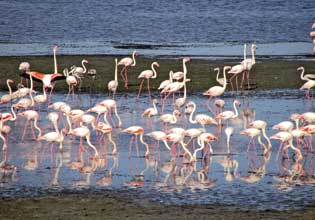 The Po Delta: Not only birdwatching
The Po Delta: Not only birdwatching
Just at the tip of the Delta, the Po river is imposed between man and disperses placid coves, marshes, lagoons and bags. This is the realm of a multitude of animal species, both migratory and resident, which find their ideal habitat in the lush vegetation: herons, egrets, hawks, wild geese, knights of Italy, several species of duck , couriers, terns, coots…
Travelling in the Po Delta means discovering a nature trail, historical, anthropological, cultural, architectural and especially poetry, through the memories of men and women have struggled in silence for daily survival. Families of fishermen and farmer , simple people with great dignity, cyclically emigrated in response to periodic floods of the Po. But the people of the Delta are back: some have decided to return to live in the territory betting on tourism or catering, and the link with the land of the river never breaks, interwoven as it is with stories, memories, and legends of fishermen.
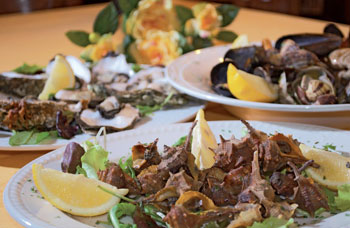 1 ) PORTO TOLLE: At lunch with the “poet fisherman”
1 ) PORTO TOLLE: At lunch with the “poet fisherman”
A fisherman was also Berto Boscolo “Morosini”, born in 1915 into a family of fishermen and farmers of Venetian origins. Despite his education was limited to reading and writing, Berto cultivated for a lifetime love for poetry, so that he is known as the “fisherman poet.” Father of 8 children, in the 60s he “invented” summer restoration by building a wood “hut” on the beach of the island of Bastimento. And it was a fair insight: when, because of the silting of the water, the boat transit became problematic, he decided with his family to transfer the refreshment along the scenic route of the Sacca di Scardovari. Thus was born Marina 70, one of the local pioneers of the restoration in the Delta: four of the eight children of Berto along with a large group of grandchildren, have engaged in the restaurant offering traditional cuisine based on the freshness of the raw material that only the family tradition of fishing can provide. The fish comes from nearby markets of Scardovari, Pila, Goro, in addition to fishing friends that reserve at the Marina 70 the most prized catch of the day, as is the case for the eels. Another classic dish is the “saore”, fish that is fried and then marinated with onion, oil, vinegar and a little sugar. Among the appetizers, the clams and mussels are from Scardovari: it could not be otherwise, since from the bright windows of the restaurant you can see the fishermen of the bag that collect them. Among the main courses, the seafood risotto with Vialone Nano Delta and spaghetti with clams, or “sepioline” and peas.
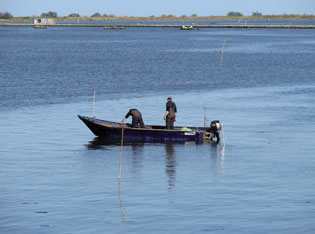 2 ) SCARDOVARI: The paradise of seafood
2 ) SCARDOVARI: The paradise of seafood
But are the mussels and clams from Scardovari (Rovigo) so special? To manage these seafood is the Consorzio Cooperative Fishermen Polesin , which brings together 14 cooperatives with a total of 1,460 active fishermen in a vast area between Baramarco, Pila, Passon, Sacca and Sacca Canarin Scardovari. The Consortium was founded in the early 70s – says the president Maurizio Crepaldi. At the end of the ’70s started the first experiments of introduction into the lagoon of clam, a species native to tropical seas that has been joined to native species. This new species is very well adapted to the local environment, colonizing large areas of the lagoon. Today the fishermen of clams are about 1,460 with 10,000 tons of clams and 80,000 tons of mussels collected annually (70% of the national production of these molluscs), so that the clams are called “black gold of the Polesine.
Another institution for catering is the Locanda Ristorante da Renata, in Bonelli di Scardovari, just a few minutes from the Consortium. Maurizio Passarells, the owner, tells us its story. “In 1940, my grandparents had a shop here with food, a bakery… it was selling a bit of everything: the classic shop/ village inn. In the mid-’70s, my father decided to open the restaurant, and since then there’s my mother in the kitchen, Renata. In 1984 I decided to just focus on food restaurant. With me are my son, Mattia, who is 28 years old and my mother, who at 79 still comes and goes from the kitchen and gives a valuable hand.” To the question of what are the local specialties, Mauritzio, smiling, says: fresh fish. Which one? It depends, he says, on the market, the season, the day … ‘Of course we have mussels, clams and oysters from Sacca di Scardovari. Then scallops, homegrown hoods , sea snails, mantis shrimp, seafood salad, sepioline stew with polenta, risotto Polesana-style, spaghetti alle vongole. Our specialty is the grilled eel, which lives in brackish water, which has a very delicate taste…”.
3 ) SANTA GIULIA DI PORTO TOLLE: From fishing tourism to tavern
Another woman of the Delta, a family of fishermen, a story of connection with the river and the lagoon in Santa Giulia di Porto Tolle, Ms Arcadia gives her name to the Osteria Arcadia. Everything is born from recreational fishing in 2003 to carry tourists on boat tour in the Delta. “Upon returning from the trip, many were asking for advice on where to eat, hence came the idea of the restaurant. We started with the idea of bringing the restaurant home cooking, with dishes prepared just in season. We prepare the mussels in about 20 different ways: cold, au gratin, with leeks and saffron, parsley and garlic, with fresh tomatoes in soup… We try to enhance blue fish and really like the fried lagoon fish and seafood. Among the first courses, spaghetti with meat sauce of mussels, clams, cockles, and among second courses, as well as fried, baked fish, pan-cooked cod, cuttlefish, all served with white polenta from corn flour Biancoperla. In the winter we also offer game of the territory: but the main dish is the risotto of “folaga”, which is very unique and requires experience.”
4) PORTO VIRO: Scampi with bufala mozzarella
In Porto Viro the Restaurant Zafferano tells a different story. Michele, Alessandro and Adriano, three friends and former classmates, in 2001 decided to start the catering business, making the “base” in what was once an ancient restaurant. The style that the three give the cuisine is creative and stylish, with references to tradition but always with an innovative perspective. The activity works, and the three friends in 2005 inaugurated the restaurant. The proposal is based, needless to say, on fish, which comes from the markets of Scardovari, Chioggia, Goro and Pila, and because Zafferano has always and only fresh fish, the menu changes daily. Among the fish most commonly used in the kitchen, , redfish, umbra, prawns, all served with an impeccable presentation. “We focus on more innovative dishes, because from the beginning we did not want to compete with the traditional restaurants in the area” explains Alessandro. The entrees are about a dozen, different every day, from raw vegetables to shellfish. Some examples? Norway lobster, mozzarella and ice, scallops and fresh spinach. Among first courses, classic homemade pasta, risotto with scampi and lemon or the liquorice powder, or curry, granny smith apple and shrimps. The wine cellar offers about 400 labels.
5 ) ROSOLINA: The market for vegetables and cycling routes
Driving along the Romea, which connects Venice to Ravenna along the Adriatic coast, we reach the Fruit and Vegetable Market of Rosolina, from which comes the vast majority of the vegetables that we find in restaurants. Due to the sandy soil below the sea level, on the territory of Rosolina excellent tomatoes are grown, but the prince is round radicchio, along with potatoes, onion, pumpkins, zucchini, eggplant, peppers, lettuce and salads, melons and watermelons. Here we are finally at one of the the most well-known shores of Polesine, Rosolina Mare. Along the road that connects Volto to the sea, we find the signs for the Via delle Valli, a wonderful route for cycling, with the canal on one side and the valley on the other: through magical landscapes, with the sky reflected in the waters, a multitude of plant and animal species, ancient buildings that recall the name of the noble Venetian families, such as the oratory Moceniga or Casone Venier. The road leading to the mouth of the Po di Levante, in front of which lies Cavallari with its beach and on the left , the island of Albarella, big, green and cured.
Let’s get back on the road that leads to Rosolina along the right bank of the Adige. We realize that we are close to the sea when we begin to see the forests of oaks, poplars, pines, willows, junipers, tamarisk, and shaded undergrowth with holly, ivy, viburnum… The beach of Rosolina stretches from the mouth of the Adige to the Port of Caleri, right in front of Albarella, and it’s really wide, with a deep coastline, crossed by a bicycle and pedestrian walk behind a cordon of dunes and tamarisk, which overlooks the bathing establishments.
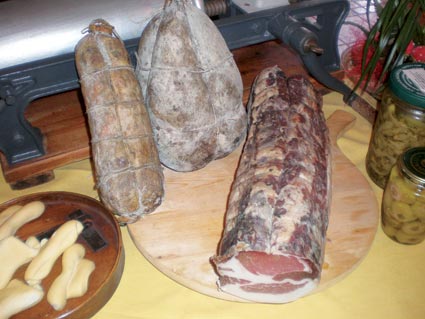 6) ARIANO IN POLESINE: The meats from the authentic country cuisine
6) ARIANO IN POLESINE: The meats from the authentic country cuisine
The Polesine never ceases to surprise us: in addition to seafood and fishing traditions, we find a rooted food culture tied to the land, livestock and processing of meats. Products manufactured in a country torn by the sea and the flooding of the Po and Adige, thanks to the hard work and tenacity of generations of farmers. If, as we have seen, the gastronomic offer is mainly based on fish, there is no shortage in the territory of products actually more related to the land, the peasant culture here that always accompanies the fishing. So, let’s get to know the meats produced by Graziano and Giancarlo Tumiatti in their farm of Rosolina, about twenty kilometers west from Porto Tolle. The brothers Tumiatti have christened their salami with the curious name “Pork in the Park of the Po Delta”, to emphasize the strong link with the territory. Today the company produces about 200 tons per year of salami and sausages, plus about 10 pounds of fresh meat that is sold in the farm shop.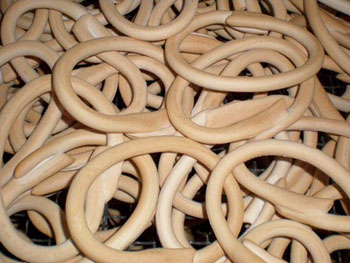
7) LOREO: The village of “pan biscotto”
And to accompany these scented cold cuts? Even in this case, Polesine gives us the answer: precisely Loreo, a town along the provincial road that connects Rosolina to Adria and Rovigo, which is famous for the “Bread of Loreo.” “Our bread is not distinguished by the use of special materials, shapes or unusual ingredients: the true success is due to the recipe, which has remained the same for generations” says Marco Nordio, the manager along with Mauro Destro and Roberto Zennaro of the bakery of the village, “The Bread of Loreo “. The shapes of bread are different: it goes from donuts, to form a kind breadstick, up to Bussolà, typical bread of Chioggia preserved for several months. Every day up to 12 tons of bussolà are made here, to give you an idea! The process removes all the moisture from the bread, making it crumbly and crunchy, and allowing storage for up to six months.
The Loreo bread is traditionally eaten with a good slice of homemade sausage and a glass of red wine, and is the protagonist of the Bread Festival which takes place every year in the village square on the third Sunday of June.
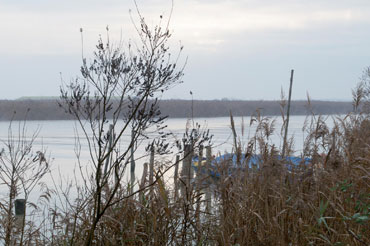 8) BAGNOLO DI PO: the scents of Farmhouse Valgrande
8) BAGNOLO DI PO: the scents of Farmhouse Valgrande
In the heart of Polesine the Farmhouse Valgrande is the perfect place for a relaxing and peaceful break. The dishes of the restaurant are made from meats processed in the company, sweet ham Montagnana, and sweet and sour vegetables. Here we find the family tradition of homemade egg pasta topped with sauces of vegetables and meat, cappelletti in capon broth, and rice from the Delta. The proposals are meat chicken, guinea fowl, capon, duck, goose and rabbit reared on the farm. Next to the classic donut “brazadèla” served at breakfast you can taste the “zaleti”, jam tarts prepared in the summer, trifle, chocolate salami, sbrisolona. Valgrande is rather a lifestyle, a set of feelings and emotions that wraps things and people, and that you do not appreciate if you are not in tune with the refined simplicity and sincere atmosphere that you breathe in company of Monica and Alberto, the owners, who personally take care of the reception of guests.
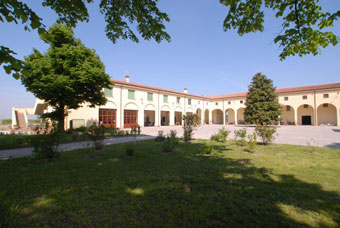 9) SAN MARTINO DI VENEZZE: Good wine at Farmhouse Corte Carezzabella
9) SAN MARTINO DI VENEZZE: Good wine at Farmhouse Corte Carezzabella
The Farmhouse Corte Carezzabella is located in the spaces of the farm built in the early decades of the 20th century. The resort is nestled in the peace of the countryside and is the starting point for excursions to nearby parks and some of the Delta areas or the Euganean Hills. In the old barns today are the guest rooms, the room is the library of the carpenter and the blacksmith the kitchen in the rooms where you would admit trucks and tractors , today there are dining room and living room. About half of the 60 acres the company is devoted to the cultivation of asparagus while the rest is divided among orchards of apples, pears, peaches and cherries, and plots of vegetables in summer and winter. Also 2 acres are planted with vineyards, from which the great red wine TEMETUM is made.
10) RAVENNA: A cultural stage to close our route
Ravenna is known as the city of mosaics, and within its walls is the richest heritage of mosaics dating from the fifth and sixth centuries, and many early Christian and Byzantine religious buildings, monuments, churches, baptismal fonts and mausoleum, reflecting its great political, commercial and artistic value in the succession of different civilizations. The city that inspired Dante, Boccaccio, Byron and Klimt is surrounded by the beauty of the natural environment surrounding it, from the pine forests to the sandy beaches of the Adriatic. Ravenna is a must-see for those who want to combine the culinary delights of the Po Delta with its artistic and historical highlights: with Ferrara, Chioggia, Venice and Bologna, Ravenna stands out as one of the finest cultural destinations in the area.
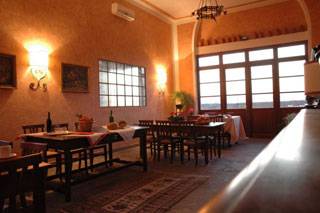 For a stay of discovery of Ravenna, we suggest the Farmhouse La Sabbiona, which offers accommodation in a rural residence surrounded by beautiful hills, situated in a panoramic position just a short distance from Faenza, city of ceramics. The company has 28 hectares of land, of which 12 are destined to vineyards, while the remainder hosts cereals, fruit and shallot. In this area rich in art and history, the Altini family want to keep the old flavors and traditions, offering accommodation in rooms decorated with antique furniture, restaurant service with typical local dishes, the opportunity to participate in the work of the fields, and cooking classes in search of ancient flavors.
For a stay of discovery of Ravenna, we suggest the Farmhouse La Sabbiona, which offers accommodation in a rural residence surrounded by beautiful hills, situated in a panoramic position just a short distance from Faenza, city of ceramics. The company has 28 hectares of land, of which 12 are destined to vineyards, while the remainder hosts cereals, fruit and shallot. In this area rich in art and history, the Altini family want to keep the old flavors and traditions, offering accommodation in rooms decorated with antique furniture, restaurant service with typical local dishes, the opportunity to participate in the work of the fields, and cooking classes in search of ancient flavors.
Another destination for a relaxing vacation is the Farmhouse La Prosciutta, which offers rooms with antique-style of Romagna, recovering an old farmhouse, and maintaining tile floors and grit where the restructuring allowed it, while at the same time offering all the comforts of the present day. A valley offers several possibilities for cyclists and mountain bike, in a meeting between the wide sandy beaches of Ravenna and the wild nature and authentic landscapes in the Park of the Po Delta.
- Tags:
- bird watching
- blue fish
- clams
- diving holidays
- farm ferrara
- farm Venice
- farmhouses Rovigo
- fish cool restaurants
- fishing
- holidays in Chioggia
- italian cuisine
- italian food and wine
- meats Romagna
- mussels
- Po Delta
- Po river
- polesine
- polesine cuisine
- Ravenna cottages
- restaurants ferrara
- sapori d'italia
- seafood
- seafood restaurants Romagna coast
- the delta of the little park
- wine and food Emilia-Romagna
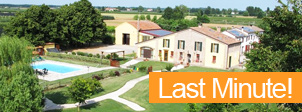
Comments are closed.